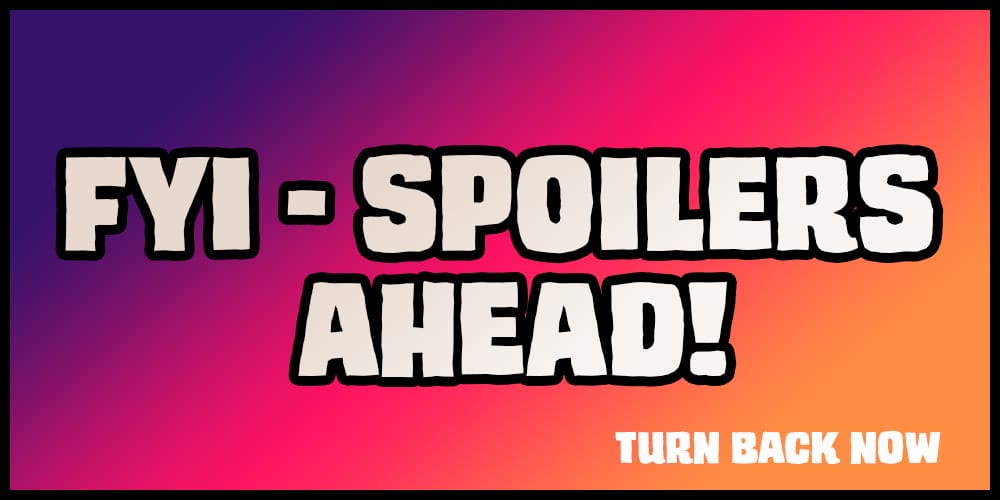Available now from Boom! Studios, Buffy the Vampire Slayer: Willow #3 builds more delicious suspense with deliberate use of color and slow payoff of meticulously planted clues. Subtitled “The Best Bean,” this issue satisfies as much as it teases on multiple levels, as written by Mariko Tamaki, illustrated by Natacha Bustos, colored by Eleanora Bruni, and lettered by Jodi Wynne.
Given that this is issue three in a five-issue series, we’re around the middle of the story. Here, we readers find symbols unravel, relationships change, and more questions arise. The end approaches, but it’s not quite in focus.

Picking up after the second issue’s happy bonfire ending, Willow wakes in her hotel bed, experiencing a déjà vu of the previous morning. But it’s definitely a new day since Abhainn’s energy has totally shifted. Where the town was virtually empty the day before, it’s now teeming with activity. It’s as if someone hit the reset button.
Groundhog Day
Further, whereas Aelara was the only one kind and attentive to the new arrival, now everyone acts cordially toward Willow. In a different world, such a reaction might be natural. It does take some time to welcome a new person in a small, remote community, so it makes sense that Abhainn’s witches might have needed a bonfire to warm up to Willow. However, Tamaki and Bustos’ visual and verbal references clue us into the underlying magical manipulation going on.
The first of these signals is the tiny pink rose Aelara pinned on Willow’s sweater in the previous issue. I had to rewatch “Once More, With Feeling,” the iconic musical episode of the TV series, to get it. In the episode, Tara finds out that Willow performed a memory-erasing spell on her. Willow used a flower called Lethe’s Bramble to augment her spell, which Tara mistook for a love token and affixed to her sweater.
With the understanding that Aelara’s framing in the book plays up the attraction and romance between her and Willow, the use of this device feels right. It’s both a genuine token of affection and a tool for Aelara’s more sinister seduction. Not to mention it’s a fun nod to the fans of the show.
A Powerful Spell
Despite Willow being under Aelara’s spell, she’s no fool. Willow quickly notices the shift in attitude toward her and the Groundhog Day feel of it all. She goes so far as to confront Aelara about it, asking the witch if Abhainn is home to a cult. Aelara, still in seduction mode, denies Abhainn is a cult, describing it as an innately magical place. She insists that it’s a commune for witches where they share power.
In a splash page that mirrors a splash from issue two, Aelara takes Willow’s hands, guiding her to feel the power flowing through them and an apple tree next to them. It’s this demonstration that reveals to Willow how much power she holds within.
What’s so seductive about this page is the close-up on Willow’s face. It floats in the middle of the page between disconnected images of the two women’s hands. Composed like a dream, the page communicates how loved and understood Willow feels in the moment. But, unlike the bonfire scene, this splash doesn’t hold the sense of freedom and joy that marked the end of issue two. Instead, it shifts the narrative into one of entrapment.
It’s A Trap!
Bolstering the entrapment angle is the reappearance of the crows from before, introduced in contrast to Willow’s interactions with Aelara. When Willow leaves Aelara on the promise to join her for a lentil soup dinner, she seems a bit disoriented, still reeling from Aelara’s magic. (Side note: Anyone else think Aelara’s lentil soup could be a subtle reference to Arthur Miller’s The Crucible?) She wanders into the forest and meets a perfect line of crows in the trees at Abhainn’s outer limits.
Crows, as I’ve noted before, mark the space between spiritual or magical realms and the real world. At this point in the story, however, they seem to not only be tangible symbols of Abhainn as a liminal space but perhaps guardians of this magical town. They stop Willow in her tracks right before a group of four women pops up behind her, asking if she’s lost. Willow uses her quirkiness to assuage any concern, and the women walk away. One of the women in the group gives Willow a terrified look as she walks away. (Suspiciously, this woman resembles Amber Benson, who played Tara in the show.) It’s then that Willow decides something’s really wrong, and she has to investigate.
“The Best Bean” excites and tantalizes by beginning to payoff this symbolism. Adapting key show elements also cleverly hints at character motivation. While the writing could stand on its own, illustration and color choices employ a distinct language to reinforce the story.
The Color of Magic
The fuchsia and purple appear to be favorites of the colorist throughout the series. In issue three, these colors are used for sunset in the final scene. The final half-page panel features the black silhouettes of the crows in a dark purple sky. Purple, famously a color of royalty, can symbolize mystery and spiritual growth.
Fuchsia, a mix of red and purple, symbolizes confidence and maturity. Its use as background in the moment Willow hears the four women and its contrast with purple highlight the themes of the story. This is Willow’s journey to confidence and magical growth.
Willow #3 makes for a brilliant midpoint to a limited run. It leaves one both longing for and dreading its conclusion. Was Aelara lying to Willow? Is Abhainn really a cult? Was that Tara among the group of four? With suspense this good, it’s worth waiting another couple issue to find out.

